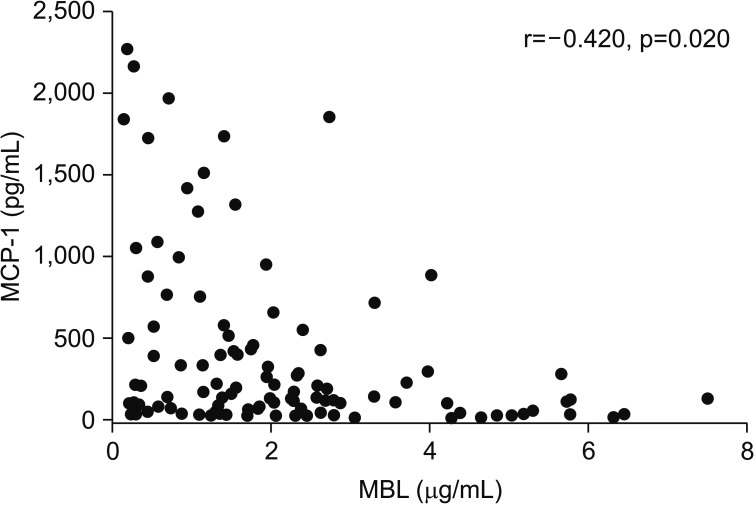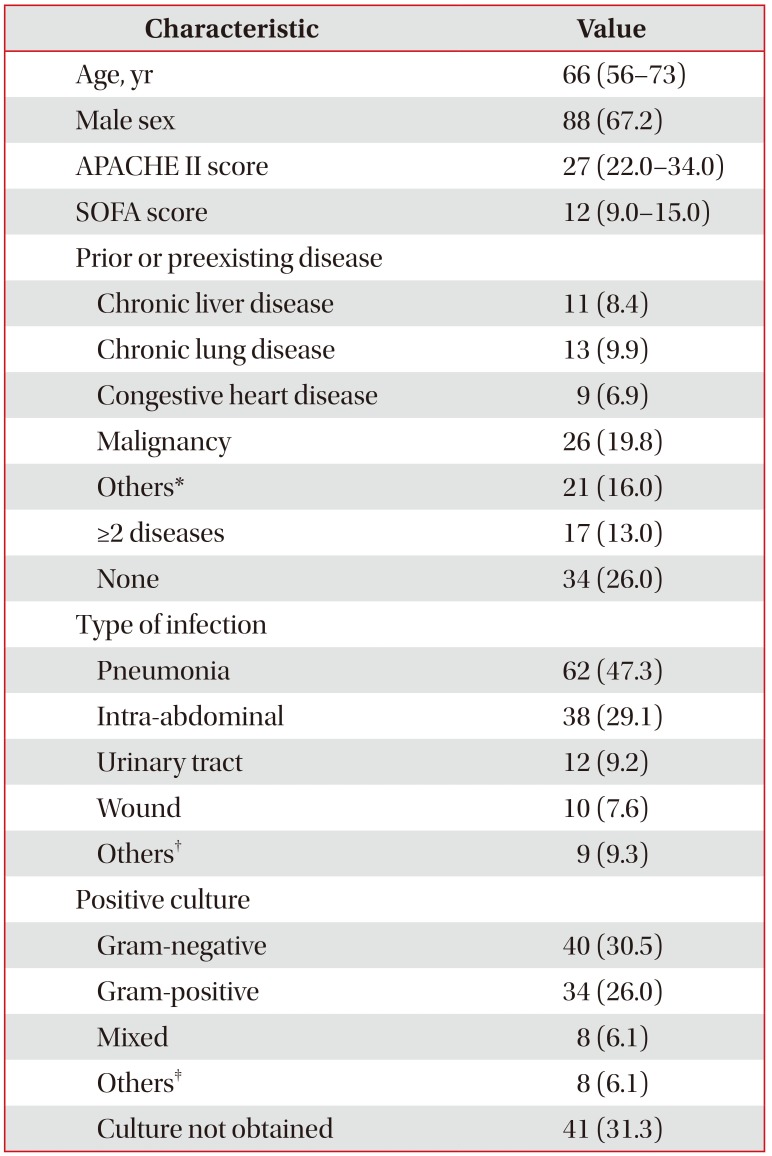1. Angus DC, Linde-Zwirble WT, Lidicker J, Clermont G, Carcillo J, Pinsky MR. Epidemiology of severe sepsis in the United States: analysis of incidence, outcome, and associated costs of care. Crit Care Med. 2001; 29:1303–1310. PMID:
11445675.

2. Moreno R, Afonso S, Fevereiro T. Incidence of sepsis in hospitalized patients. Curr Infect Dis Rep. 2006; 8:346–350. PMID:
16934192.

3. Annane D, Aegerter P, Jars-Guincestre MC, Guidet B. CUB-Réa Network. Current epidemiology of septic shock: the CUB-Rea Network. Am J Respir Crit Care Med. 2003; 168:165–172. PMID:
12851245.
4. Kwiatkowski D. Genetic dissection of the molecular pathogenesis of severe infection. Intensive Care Med. 2000; 26(Suppl 1):S89–S97. PMID:
10786964.

5. Sorensen TI, Nielsen GG, Andersen PK, Teasdale TW. Genetic and environmental influences on premature death in adult adoptees. N Engl J Med. 1988; 318:727–732. PMID:
3347221.

6. Hill AV, Allsopp CE, Kwiatkowski D, Anstey NM, Twumasi P, Rowe PA, et al. Common west African HLA antigens are associated with protection from severe malaria. Nature. 1991; 352:595–600. PMID:
1865923.

7. Turner MW, Hamvas RM. Mannose-binding lectin: structure, function, genetics and disease associations. Rev Immunogenet. 2000; 2:305–322. PMID:
11256742.
8. Moine P, Abraham E. Immunomodulation and sepsis: impact of the pathogen. Shock. 2004; 22:297–308. PMID:
15377883.

9. Martins PS, Brunialti MK, da Luz Fernandes M, Martos LS, Gomes NE, Rigato O, et al. Bacterial recognition and induced cell activation in sepsis. Endocr Metab Immune Disord Drug Targets. 2006; 6:183–191. PMID:
16787293.

10. Garred P, Strom JJ, Quist L, Taaning E, Madsen HO. Association of mannose-binding lectin polymorphisms with sepsis and fatal outcome, in patients with systemic inflammatory response syndrome. J Infect Dis. 2003; 188:1394–1403. PMID:
14593599.

11. Koch A, Melbye M, Sorensen P, Homoe P, Madsen HO, Molbak K, et al. Acute respiratory tract infections and mannose-binding lectin insufficiency during early childhood. JAMA. 2001; 285:1316–1321. PMID:
11255386.

12. Fidler KJ, Wilson P, Davies JC, Turner MW, Peters MJ, Klein NJ. Increased incidence and severity of the systemic inflammatory response syndrome in patients deficient in mannose-binding lectin. Intensive Care Med. 2004; 30:1438–1445. PMID:
15127191.

13. Kakkanaiah VN, Shen GQ, Ojo-Amaize EA, Peter JB. Association of low concentrations of serum mannose-binding protein with recurrent infections in adults. Clin Diagn Lab Immunol. 1998; 5:319–321. PMID:
9605984.

14. Summerfield JA, Ryder S, Sumiya M, Thursz M, Gorchein A, Monteil MA, et al. Mannose binding protein gene mutations associated with unusual and severe infections in adults. Lancet. 1995; 345:886–889. PMID:
7707811.

15. Cohen J. The immunopathogenesis of sepsis. Nature. 2002; 420:885–891. PMID:
12490963.

16. Fraser IP, Koziel H, Ezekowitz RA. The serum mannose-binding protein and the macrophage mannose receptor are pattern recognition molecules that link innate and adaptive immunity. Semin Immunol. 1998; 10:363–372. PMID:
9799711.

17. Bone RC, Balk RA, Cerra FB, Dellinger RP, Fein AM, Knaus WA, et al. Definitions for sepsis and organ failure and guidelines for the use of innovative therapies in sepsis The ACCP/SCCM Consensus Conference Committee American College of Chest Physicians/Society of Critical Care Medicine. Chest. 1992; 101:1644–1655. PMID:
1303622.
18. Huh JW, Song K, Yum JS, Hong SB, Lim CM, Koh Y. Association of mannose-binding lectin-2 genotype and serum levels with prognosis of sepsis. Crit Care. 2009; 13:R176. PMID:
19891773.

19. Lee SG, Yum JS, Moon HM, Kim HJ, Yang YJ, Kim HL, et al. Analysis of mannose-binding lectin 2 (MBL2) genotype and the serum protein levels in the Korean population. Mol Immunol. 2005; 42:969–977. PMID:
15829288.

20. Sumiya M, Super M, Tabona P, Levinsky RJ, Arai T, Turner MW, et al. Molecular basis of opsonic defect in immunodeficient children. Lancet. 1991; 337:1569–1570. PMID:
1675710.

21. Lipscombe RJ, Sumiya M, Hill AV, Lau YL, Levinsky RJ, Summerfield JA, et al. High frequencies in African and non-African populations of independent mutations in the mannose binding protein gene. Hum Mol Genet. 1992; 1:709–715. PMID:
1304173.

22. Madsen HO, Garred P, Kurtzhals JA, Lamm LU, Ryder LP, Thiel S, et al. A new frequent allele is the missing link in the structural polymorphism of the human mannan-binding protein. Immunogenetics. 1994; 40:37–44. PMID:
8206524.

23. Serbina NV, Jia T, Hohl TM, Pamer EG. Monocyte-mediated defense against microbial pathogens. Annu Rev Immunol. 2008; 26:421–452. PMID:
18303997.

24. Gomes RN, Figueiredo RT, Bozza FA, Pacheco P, Amancio RT, Laranjeira AP, et al. Increased susceptibility to septic and endotoxic shock in monocyte chemoattractant protein 1/cc chemokine ligand 2-deficient mice correlates with reduced interleukin 10 and enhanced macrophage migration inhibitory factor production. Shock. 2006; 26:457–463. PMID:
17047515.

25. Mukaida N. Pathophysiological roles of interleukin-8/CXCL8 in pulmonary diseases. Am J Physiol Lung Cell Mol Physiol. 2003; 284:L566–L577. PMID:
12618418.











 PDF
PDF ePub
ePub Citation
Citation Print
Print



 XML Download
XML Download